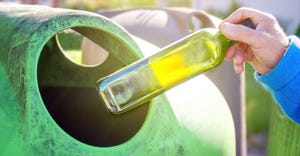Mapping Landfill Space NASA Style
January 1, 2001
Kevin P. Corbley
Recognizing that air space is a landfill's most valuable asset, NASA, in 1997, funded a proposal under its Earth Observation Commercial Applications Program (EOCAP) for new topographic mapping techniques to help the waste industry more effectively manage the available space. EOCAP's objective is to transfer new, commercially viable remote sensing and digital mapping technologies from the research sector into the commercial world.
Denver-based EnerQuest Systems won the EOCAP award with a proposal to apply its Remote Airborne Mapping System (RAMS) to landfill sites.
The RAMS application appealed to NASA because it uses laser altimetry, which is used for topographic mapping and three-dimensional modeling.
EnerQuest uses Light Detection and Ranging (LIDAR) technology, the primary technology behind the RAMS system, to directly measure the distance between the aircraft and ground by bouncing light pulses from a scanning laser altimeter off the land surface. The LIDAR is integrated with an Inertial Measurement Unit and onboard Global Positioning System (GPS) to correlate precise "x" and "y" geographic coordinates, and a "z" elevation value.
Onboard GPS eliminates the need to place markers and targets on the ground, according to EnerQuest.
Prior to a flight, EnerQuest surveys only one identifiable point to tie the entire data set to a mapping coordinate system.
The RAMS apparatus emits these pulses in a 3,000-foot swath to collect measurements for a wide area under the aircraft in a single pass. In its standard operating mode of 15 kilohertz (kHz), RAMS acquires 250,000 points per square mile with 6-inch elevation accuracy. Topographic maps generated from this data generally have a 2-foot contour interval with a 3-foot posting, or point spacing.
Working with Scott Cervenka, program manager for operations E-business systems development at Waste Management Inc., Houston, EnerQuest conducted its first flight over a solid waste disposal site in December 1997 and during the next two years, mapped 18 landfills operated by three solid waste disposal companies.
In a typical project, EnerQuest planned flight lines over the landfill using a paper map. The precise coordinates then were entered into the aircraft navigation system, which guided the plane through each pass. One ground technician was sent out to establish a GPS base station on the single ground control point needed for the flight.
Flights typically were conducted at 5,000 feet above ground level at air speeds of approximately 120 knots. The average landfill size was 600 acres. The smaller landfills could be covered in a single pass, while the larger ones required four or five sweeps. The actual collection of LIDAR points and stereoimagery only took minutes.
"In one landfill, the accuracy of the LIDAR was roughly plus or minus 1 inch," Cervenka says. "Compare that to the plus or minus 1-foot error in photogrammetry, and you're looking at a substantial variation in the volumetric calculations between the two methods." Cervenka adds that photogrammetry technology was unable to detect several months worth of solid waste volume.
"[On the other hand] the high accuracy of LIDAR results from its density of point collection," says Don Wicks, EnerQuest president. "No ground survey can economically collect 250,000 actual measurements in a square mile."
Previous EOCAP results showed that mapping with LIDAR can be cost-competitive with other techniques when multiple landfills are mapped in a single flight. The cost of the LIDAR application varies from $8,000 to $10,000, depending on the landfill's size. Because aircraft and system mobilization fees account for a large percentage of the total cost, per-site costs were reduced as the number of landfills mapped increased per flight.
"We knew the biggest cost would be to mobilize the aircraft," Wicks says. "Whenever possible, we tried to arrange to survey more than one site in a flight. Ultimately, that will be key to the long-term financial success of this application in the waste industry."
For most landfill clients, EnerQuest delivered three primary products - elevation contour maps, digital aerial photographs and volumetric calculations of remaining space. EnerQuest processed the data and delivered products within two weeks after the flight.
You May Also Like


